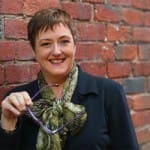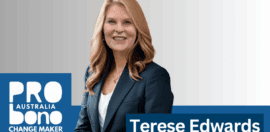Turning Outward for Community-Wide Change
30 October 2014 at 10:46 am
A visiting US Collective Impact guru tells Pro Bono Australia News why he is urging Not for Profits to de-prioritise internal benchmarks – calling for them to instead take the bold step of turning outwards to their communities. 
Rich Harwood is a US Public Innovator and founder of The Harwood Institute for Public Innovation – a nonpartisan, independent Not for Profit that teaches and coaches people and organisations to tackle social problems and change how communities work together.
Supported by United Way Australia, Harwood and his team are visiting Australia to share his knowledge on Collective Impact, civic culture and community building.
In addition to meeting with community leaders in Melbourne and Adelaide, in Sydney this week Harwood has been part of a public innovators lab with 100 others. The main purpose for Harwood’s visit is the launch of a three year program with the Local Community Services Association in NSW.
Pro Bono Australia News spoke with Harwood about building civic culture, the universality of his principles for community building and the role of leadership in moving Collective Impact projects forward.
Turning Outward
The crux of Harwood’s theory is that actors in Collective Impact or community projects should turn outward, focusing on the communities at hand rather than the benchmarks of success set within their organisations.
“The [Harwood] Institute’s put millions of dollars into research about how civic-minded organisations operate and what their frame of reference is in decisions they make,” he says.
“What we’ve consistently found in research and on the ground working in communities is that so many of us have turned inward and the point of reference is in our own programs, our own initiatives, our own organisational survival – even when we’re saying we need to engage our communities and mobilising the resources of our communities.
“I hear that consistently – that inward aspect knows no geographic boundaries.
“It was echoed here in Australia and the groups I’ve met with. We immediately turned to talk about our programs and initiatives as opposed to talking about our communities, and the type of communities we want to create for the people who live in those communities and make those communities what they are.”
Harwood speaks of one struggling US community, Battle Creek in Michigan, where the merits of a turning outward approach are clear. The city struggles with high poverty levels despite its fame for housing the world headquarters of the Kellogg corporation.
“Lots of of money has been ploughed into Battle Creek with a lot of good intentions, but when we engaged people in that community about their aspirations and the condition of the community, what they told our partners on the ground was that there had been too many initiatives in that community without making a dent.
“Their aspiration at this point is to see something work – the size of it doesn't matter, what matters is that they have demonstrated that they can come together and get something done… to create a community where every individual has opportunities.”
He is using his Australian trip to share these philosophies with Australian community organisations, meeting with Not for Profit leaders in Melbourne last week.
“The conversation we had was, what is it going to take to get organisations and groups to make the community the reference point for their work in Collective Impact as opposed to our own conference rooms?
“Then, how do we understand the underlying conditions of the communities in which we’re working, so that we can be smart about meeting the community where it is as opposed to where we hope it to be, so we can actually develop strategies that fit the local context and have a real chance to succeed?
“I think there’s a realisation among the groups I talk to here in Australia that no matter how good an individual organisation is that many of challenges we face we can’t resolve and address on our own so we need to come together and work more collectively as a community,” Harwood says.
A Sustainable and Enabling Environment
For a lot of groups who who want to turn outward, and there are many, there’s then the questions of, “how do I do this in practical terms?”.
This might encompass:
- What does it really mean for me to engage the community authentically in a conversation about their aspirations?
- How do i make sense of the what the community has told me?
- How do I integrate that knowledge with the data and evidence based decision-making that I’m trying to use to make good, solid judgements about where we place our resources and the steps we take in our community work?
- How is it that I need to realign the culture of my organisation and the skillsets of the people who work in my organisation so that we can really do this work in a smart, solid way?
The key in Harwood’s theory is the creation of a “sustainable and enabling environment” within the organisation.
“Communities operate like ecosystems – there are different factors that make up its health. In a healthy ecosystem you’d see a balance of those factors,” he says.
“We know that if we can create that enabling environment as we’re doing work on specific issues, it’s transferable in communities to other challenges that we face, because essentially we’re rebuilding the ecosystem of that community, and it can be applied to any issue.”
Harwood says the Institute’s work has isolated nine key factors that help create that sustainable and enabling environment, among them:
- Are there different layers of leadership in the community that people trust?
- Are there organisations that can bring people together across dividing lines and help illuminate people’s aspirations and challenges in the community?
- Is there conscious community conversation?
- Is engagement an ethos within the community?
- Is there a common sense of purpose within the community?
“What the trick is in terms of creating a sustainable and enabling environment, and this is something the Collective Impact community needs to be thinking really critically about – is, when how is what we’re trying to move the needle on in a particular issue, we actually create this enabling environment so the community has the capacity wherewithal the norms, to make a go of it,” Harwood says.
“We’re building the capacity and the capability of these organisations in these communities so the community can determine their own future.
“When we do work with Local Community Services Association in NSW, our staff aren’t going to be on the ground in those communities – we’re developing the staff in LCSA and embedding our practice in their local organisations so that they can bring people to determine what’s important and what matters to them in their local communities.
Leadership for Change
Harwood acknowledges that barriers remain to universal implementation of his approach.
“[Some organisations’] mindsets are driven by a work orientation that they have to do everything that they can to ensure their organisation survives, that they have to get the credit…they jockey for position and turf.
“If they are really to be effective, they’re going to have to make the community a reference point for their work, because that’s actually where the work takes place, The deeper their knowledge of the community and its conditions and aspirations, the more likelihood they will succeed. That’s a tougher nut to crack.”
Also pertinent to Harwood’s philosophy is the notion of leadership – and the drive for a more adaptive leadership style rooted in the community.
“I’ve come to believe that we need leaders in communities who recognise that it’s in their interest to develop other leaders. As the competition for resources increases, as people want more credit for the work they do, as folks jockey for more positioning…we see the leadership question as a zero sum game when in fact the only way we can succeed is to have a healthy cadre of leaders across the community,” he says.
Harwood says the principles of his approach are transferable and universal, regardless of community, state or country.
“We’re working with thousands of communities across the US, our work has organically spread to about 30 countries, and what we know at this point is that the orientation and the practices are the things that we can apply to any of the contexts that we’re in,” he says.
“The question and challenge for those of us in different contexts is whether we’re open enough to learn about what those different contexts are, and are we willing to see and hear different people, even when they say things that might be troubling to us or challenge the way that we work?
“I think whether it’s Australia or the US, we’re all concerned about how we marshal our collective resources to address some of the larger challenges we face.
“More than anything right now, what Australians want, and what Americans want, is that at least we can come together and address the issues that matter.”







